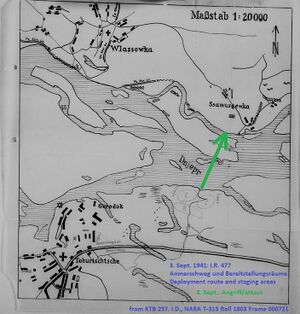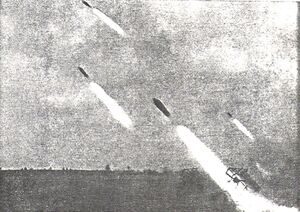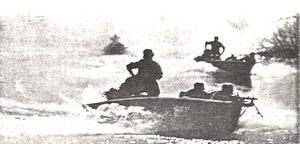8. September 1941
| GEO INFO | ||||
|---|---|---|---|---|
| Dnieper crossing[1] Gorodok~Ssamussewka | ||||
We sleep in a tent behind a bush not far from the discharge point. No sooner does the morning dawn than we drive up from our camp, startled. Our Do-Werfer (Nebelwerfer), standing behind us, have opened the concentrated fire.[2] Yelping and howling, the missiles zoom in a wide arc across the stream, leaving a fiery tail behind them. Dull thuds on the far bank tell us of the impacts. Now the artillery joins in with rumbling salvos, and under the fire of shells and rockets the assault boats rattle away. Like hunting dogs they rush out onto the water and in the middle of the stream they are only dark dots, trailing a streak-thin white wake behind them. The Russian defensive fire is now concentrated on the assault boats. High white fountains of water spray up between them, but none is hit.
Our assault troops - always about five men in an assault boat - have already gained a foothold over there after a short fight. This crossing of the stream has gone amazingly fast. The momentum of our attacks is irresistible, and even this wide stream has not been able to stop the Furor Teutonicus. The assault boats can now be followed by the slower ferries with heavy equipment. We begin to cross 8.8 anti-aircraft guns and the vehicles that go with them.[3]
Soon the first boats return, already taking prisoners with them. There are severely wounded among them, who wail and whimper harrowingly. They are taken away on a straw-padded Panje cart. The Russian artillery, having finally spotted them, is now firing on our run-off point. Heavy chunks burst with tremendous detonations, but do no damage.
|
Editorial 1938 1939 1940 1941 1942 1943 1944 1945 1946 1947 1948 1949 Epilog Anhang |
|
January February March April May June July August September October November December Eine Art Bilanz Gedankensplitter und Betrachtungen Personen Orte Abkürzungen Stichwort-Index Organigramme Literatur Galerie:Fotos,Karten,Dokumente |
|
1. 2. 3. 4. 5. 6. 7. 8. 9. 10. 11. 12. 13. 14. 15. 16. 17. 18. 19. 20. 21. 22. 23. 24. 25. 26. 27. 28. 29. 30. 31. Erfahrungen i.d.Gefangenschaft Bemerkungen z.russ.Mentalität Träume i.d.Gefangenschaft Personen-Index Namen,Anschriften Personal I.R.477 1940–44 Übersichtskarte (Orte,Wege) Orts-Index Vormarsch-Weg Codenamen der Operationen im Sommer 1942 Mil.Rangordnung 257.Inf.Div. MG-Komp.eines Inf.Batl. Kgf.-Lagerorganisation Kriegstagebücher Allgemeines Zu einzelnen Zeitabschnitten Linkliste Rotkreuzkarte Originalmanuskript Briefe von Kompanie-Angehörigen |
- ↑ With this, the division intervenes from the southeast in the Battle of Kiev (hence "Southeast Cauldron" acc. to KTB 257th I.D., NARA T-315 Roll 1803 Frame 000894 or "Annihilation Battle at the Orschiza Section" acc. to Frame 000905), of which nothing is mentioned in the diary except for the Sula crossing.
- ↑ Entgiftungsabteilung 102, at 6 o’clock (KTB 257. I.D., NARA T-315 Roll 1803 Frame 000749/58/59/66). On 14 Jan 1942 the battalion became schwere Werfer-Abt. 102 and in April, IIIrd Bn of schweres Werfer-Regiment 2. Since the IIIrd Bn of schweres Werfer-Regiment 1 was equipped with 28/32-cm-Nebelwerfer 41, it can be assumed that this weapon was also used here.
- ↑ Reseve-Flak-Abteilung 142 (KTB 257. I.D. Frame 000752)



